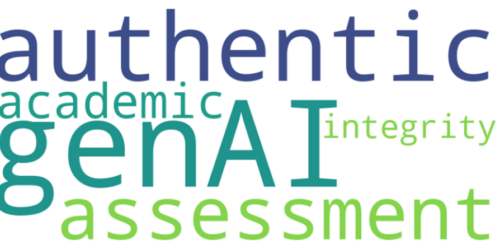
Faculty Ideas for Teaching with the GenAI Toolkit
The Generative AI Toolkit for Students (the Toolkit), developed by Conestoga’s Library and Learning Services, provides resources to help students learn more about generative AI, including Microsoft Copilot. It includes curated resources for building students’ AI literacy. The Toolkit can help you clarify and reinforce your expectations for permitted use in your course. Note that the Toolkit does not instruct students about the extent to which AI is permitted or prohibited in your course.
In the summer 2024 workshop “Teaching with the Generative AI Toolkit,” faculty identified ways to teach about the ethical and responsible use of genAI with the Toolkit. Below is a summary of their ideas, organized by type, which may be adapted for your class.
Introduce GenAI, Ethical Use, and Course Expectations
Faculty can share their expectations by incorporating the Toolkit into how they introduce the course, model the use of AI, and share assignments with students in class or one-on-one.
Show the Toolkit in the first week
Introduce the Toolkit in class as part of the learning process. Faculty suggest:
- “Review the Generative AI toolkit in class with students and show them how to use it.”
- “Showcasing it in Day 1.”
- “Maybe programs could be encouraged to present the toolkit to students during pre-term orientations.”
Discuss and practice AI prompting
Demonstrate prompting in class and discuss AI responses based on the prompts. Faculty suggest:
- “I would mention this in the class and demonstrate prompting.”
- “Compare the GenAI responses they are currently getting (without Prompt Training) to the GenAI responses they receive with Prompt training.”
- ” Prompting to generate ideas for topics for research papers on social issues in Canada. Explore how these issues are currently being addressed, what organizations are addressing them, and how.”
Explain ethical use and academic integrity
Modelling responsible use and explaining risks and limitations. Faculty suggest:
- “I will show how having good AI literacy and using it ethically within course requirements can enhance their work and reduce Academic Integrity incidents.”
- “Help students to understand its risks and limitations when considering using it for cheating purposes on assignments in my course.”
Refer to Toolkit in course documents and student meetings
Faculty suggest:
- “Referencing it in course information.”
- “Include the toolkit into the Instructional Plans and Course Shells – add the toolkit into evaluations that require its use and prove knowledge of its content.”
- “Share with students when meeting 1 on 1.”
Classroom Learning Activities
Use the Toolkit in active learning activities to give students hands-on experience, making understanding and applying AI concepts easier than just reading about them.
Brainstorm about responsible use
Brainstorming as a class how AI can be used. Faculty suggest:
- “This toolkit can help my class brainstorm ideas for responsible use.”
Scavenger hunt for site familiarity
Use the toolkit in a scavenger hunt activity. Faculty suggest:
- “I like the idea of a scavenger hunt to have students get to know the site.”
- “I will have a task and ask students to find some info, then ask them to share the ways they did that- highlighting the toolkit, which hopefully was used.”
Practice writing and citing with AI
Have students practice an activity where they reference the toolkit to cite a source.
- “Citing and referencing. I find students hesitant to reference the use of AI.”
Question-based exploration
Explore questions and possible answers with students. Faculty suggest:
- “Have students come up with questions they have about GenAI and then have them explore the toolkit to find the answer.”
Checklist development about AI privacy
Have students create a checklist for maintaining privacy while using AI. Faculty suggest:
- “Privacy Protection: Activity: Ask students to explore the ‘Protect your privacy and work!’ section and create a checklist of best practices for maintaining privacy while using Gen AI tools.”
Memo and email writing about the Toolkit
Assign a memo or email writing task where students summarize toolkit information. Faculty suggest:
- “Giving students an email or memo writing assignment where they have to summarize information from the toolkit about the proper use of AI as per the school policy.”
Read about and discuss ethical AI use
Have students discuss the ethical use of AI based on the toolkit. Faculty suggest:
- “Ethical use activity: Have students review the ‘Gen AI and Academic Integrity’ section and discuss in groups how they can use Gen AI ethically in their assignments.”
- “Use the H5P activity about Harm Considerations of LLMs to guide a discussion about unintended consequences of AI use.”
- ” To use sample topic questions to evaluate understanding/recall of material, but to AVOID using it as a gaming tool to study and avoiding review of content, understanding, and memorizing.”
Student group research activity
Have students review the site in groups. Faculty suggest:
- “In-class activity highlighting how to use CoPilot for research. Divide class into groups with a topic to research.”
- “Collaborative Activity: Develop a group activity using Copilot that encourages collaboration among students with diverse needs.”
- “Direct students to the ‘Find AI Research’ section and have them conduct a mini-research project on a specific AI topic, presenting their findings to the class.”
Case studies with the Toolkit
Use AI to assist with or complete case studies. Faculty suggest:
- “Incorporate an activity in your lesson where students get to explore a section of the toolkit and apply it to an example.” “Allow GenAI for assistance on case study to gather information subject to guidance in Toolkit.”
- “Have students use it to complete a short Case study.”
Critical analysis of AI outputs based on Toolkit criteria
Have students critique AI-generated content based on course learning. Faculty suggest:
- ” I would really like an activity where the students are asked to get a GenAI output and then compare that information to what is found within the toolkit.”
- “A student asks Copilot about how to communicate with a buyer group, and then the student critiques the suggestion based on course learning.”
Discussing industry AI use
Use the kit to discuss AI in industry or professional areas. Faculty suggest:
- “Share examples that I am aware of how professionals are using GenAI in their daily work.”
- ” Learn about AI in preparation for responsible use in industry.”
Role-play about assignments
Role-play scenarios where students must ask instructors about using Gen AI for assignments. Faculty suggest:
- “Students read the ‘Ensure you have checked with your instructor’ section and role-play scenarios.”
Ideas by Level of Permission or Integration of AI in your Course
The Toolkit does not tell students what AI use is permissible or prohibited, so it is a good idea to have a clear idea of what level of permitted use will be acceptable in your course before integrating the Toolkit into class tasks and assignments.
Integrated AI Use
Integrated AI use is a permission level that allows students to use AI in various ways for learning or assignment tasks. For integrated use, you may require students to visit or use aspects of the toolkit to prepare for or as part of their assignment, such as research projects or case studies.
Faculty suggest the following activities:
- “Have students use it to complete a short Case study.”
- “Review the Generative AI Toolkit in class with students and show them how to use it. Link it to an evaluation so that they have access to the generative AI tools.”
- “Educate the students on the positive uses of AI.”
Measured AI Use
Measured AI use is a permission level that allows students to use AI in specific ways for certain learning or assignment tasks (or part of those tasks). For measured use, you may wish to provide structured or guided exploration of the Toolkit during class or in specific assignments.
Faculty suggest the following activities:
- “Start with modeling and make it part of the first stages of the assignment.”
- “Have students review the ‘Gen AI and Academic Integrity’ section and discuss in groups how they can use Gen AI ethically in their assignments.”
- “Privacy Protection activity: Ask students to explore the ‘Protect your privacy and work!’ section and create a checklist of best practices for maintaining privacy while using Gen AI tools.”
- “Use the toolkit to encourage avoiding other online sources which can lead to plagiarism. Trustable sources.”
- ” I encourage the students to use the AI toolkit but provide the limitations. The tools I prefer now are Microsoft Copilot and Grammarly. I am not an English writing teacher.”
- “Use the H5P activity about Harm Considerations of LLMs to guide a discussion about unintended consequences of AI use.”
Limited or No Use
Limited or no use prohibits students from using AI for learning tasks or assignments. In this case, the toolkit can be used to clarify expectations, communicate concerns and ethical dilemmas, and provide further learning for independent use.
Faculty suggest the following activities:
- “Studying tool, but only once actually invested “study time.”
- “Encourage students to subscribe to updates from the “Keeping Up to Date with Gen AI” section and share new insights or developments in AI during class discussions.”
See the following Hub posts for more information:
- The Optional Use of Generative AI for more on levels of permission of AI use in your course.
- A Spectrum of Student GenAI Use for more on ways to use AI in your classroom.
- GenAI Statements for Students for scripts and riders to share with students.
Final Thoughts
The Conestoga Generative AI Toolkit for Students is designed to foster ethical and responsible AI use among students. By integrating this toolkit into classroom activities, discussions, and assignments, you can help students navigate the complexities of AI technology. The goal of using this tool in class is to enable students to build knowledge about AI while maintaining academic integrity and ethical standards.






